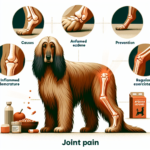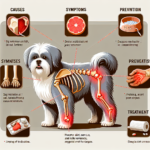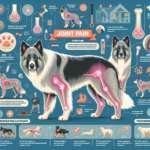Irish Red and White Setter Joint Pain: Causes, Symptoms, Prevention, and Treatment

Introduction
The Irish Red and White Setter is a distinguished and elegant breed known for its striking coat and friendly demeanor. Originating from Ireland, this breed was primarily developed for hunting and retrieving game birds. The Irish Red and White Setter is characterized by its medium to large size, athletic build, and distinctive red and white coat. These dogs are not only valued for their hunting prowess but also for their affectionate and loyal nature, making them excellent family pets.
Like many breeds, the Irish Red and White Setter is prone to certain health issues, with joint pain being a significant concern. Joint health is crucial for this breed due to their active lifestyle and genetic predispositions. Ensuring the well-being of their joints can help maintain their quality of life and prolong their active years.
Breed-Specific Joint Pain Risks
Genetic Predisposition
The Irish Red and White Setter, like many other breeds, has a genetic predisposition to joint-related issues. Common conditions include hip dysplasia, elbow dysplasia, and arthritis. Hip dysplasia is a hereditary condition where the hip joint does not fit properly into the hip socket, leading to pain and mobility issues. Elbow dysplasia involves abnormal development of the elbow joint, causing lameness and discomfort. Arthritis, a degenerative joint disease, can also affect this breed, leading to chronic pain and stiffness.
Age-Related Risks
As the Irish Red and White Setter ages, the risk of developing joint pain increases. Typically, signs of joint issues may start to appear in middle age, around 5 to 7 years old. However, some dogs may show symptoms earlier or later, depending on their genetic makeup and lifestyle. It’s essential for owners to be vigilant about their dog’s joint health as they age, as early detection and intervention can significantly improve their quality of life.
Activity Level and Joint Stress
The Irish Red and White Setter is an active and energetic breed, often used for hunting, sporting, and other high-energy activities. While regular exercise is vital for their overall health, excessive or inappropriate exercise can lead to joint stress and exacerbate existing conditions. Activities that involve repetitive motions, high impact, or sudden stops and starts can be particularly hard on their joints. It’s crucial to balance their need for exercise with the need to protect their joints from undue stress.
Common Symptoms of Joint Pain in Irish Red and White Setters
General Symptoms
Owners should be aware of the common symptoms of joint pain, which include:
- Limping or favoring one leg
- Stiffness, especially after rest or sleep
- Reluctance to move, jump, or climb stairs
- Decreased activity or playfulness
- Swelling around the joints
- Visible discomfort or pain when touched
Breed-Specific Symptoms
In the Irish Red and White Setter, joint pain may manifest more noticeably due to their active nature. Owners might observe a sudden decrease in their dog’s enthusiasm for activities they once enjoyed, such as running or playing fetch. Additionally, these dogs may show signs of pain after long periods of exercise or during cold weather, which can exacerbate joint stiffness and discomfort.
When to Consult a Vet
If any of the above symptoms are observed, it is crucial to consult a veterinarian promptly. Early diagnosis and treatment can prevent further deterioration and improve the dog’s quality of life. Regular veterinary check-ups are also essential for monitoring joint health and catching any issues early.
Preventive Measures for Joint Health
Exercise Recommendations
Maintaining an appropriate exercise routine is vital for the joint health of the Irish Red and White Setter. Low-impact activities such as swimming and walking on soft surfaces are excellent choices. These exercises help build muscle strength without putting excessive strain on the joints. Avoid high-impact activities like jumping or running on hard surfaces, which can exacerbate joint issues.
Dietary Suggestions
A balanced diet rich in essential nutrients can support joint health. Foods containing glucosamine, chondroitin, and omega-3 fatty acids are particularly beneficial. These nutrients help maintain cartilage health and reduce inflammation. Owners may also consider joint supplements, but it’s essential to consult a veterinarian before adding any supplements to the dog’s diet.
Weight Management
Maintaining a healthy weight is crucial for reducing joint stress. Excess weight puts additional pressure on the joints, exacerbating pain and discomfort. Owners should monitor their dog’s weight and adjust their diet and exercise routine as needed to keep them at an optimal weight. Regular weigh-ins and body condition assessments can help ensure the dog remains within a healthy range.
Early Screening and Monitoring
Early screening for joint issues can help catch problems before they become severe. Regular veterinary check-ups should include joint assessments, especially as the dog ages. X-rays and other diagnostic tools can help identify joint abnormalities early, allowing for timely intervention and management.
Treatment Options for Joint Pain
Non-Surgical Treatments
Non-surgical treatments for joint pain in Irish Red and White Setters include:
- Medications: Anti-inflammatory drugs and pain relievers can help manage pain and reduce inflammation.
- Physical Therapy: Exercises and therapies designed to improve joint function and reduce pain.
- Lifestyle Adjustments: Modifying the dog’s activity level and environment to reduce joint stress.
Surgical Options
In severe cases, surgical intervention may be necessary. Common surgical options include:
- Hip Replacement: Replacing the damaged hip joint with an artificial one.
- Arthroscopy: A minimally invasive procedure to clean out the joint and remove damaged tissue.
- Joint Fusion: Fusing the joint to reduce pain and improve stability.
These surgeries can significantly improve the dog’s quality of life, but they come with risks and require a thorough discussion with a veterinarian.
Alternative Therapies
Alternative therapies can complement traditional treatments and provide additional relief. These include:
- Acupuncture: Using needles to stimulate specific points on the body to reduce pain and inflammation.
- Hydrotherapy: Water-based exercises that reduce joint stress while improving strength and mobility.
- Massage: Gentle massage techniques to improve circulation and reduce muscle tension around the joints.
Lifestyle and Management Tips
Daily Care Routine
A daily care routine for managing joint pain in Irish Red and White Setters might include:
- Gentle morning walks to loosen stiff joints
- Regular, low-impact exercise sessions
- Administering prescribed medications or supplements
- Providing a balanced diet rich in joint-supporting nutrients
- Monitoring the dog’s weight and adjusting their diet as needed
Modifying the Home Environment
Making the home environment more comfortable for a dog with joint pain can significantly improve their quality of life. Consider the following modifications:
- Installing ramps to help the dog navigate stairs
- Providing orthopedic beds for better joint support
- Using non-slip mats to prevent falls on slippery surfaces
- Ensuring food and water bowls are at a comfortable height
Long-Term Management
Long-term management of joint pain involves regular monitoring and adjustments to the dog’s care routine. This includes:
- Regular veterinary check-ups to monitor joint health
- Adjusting exercise routines as needed to prevent overexertion
- Continuing with prescribed medications or supplements
- Maintaining a healthy weight through diet and exercise
- Providing ongoing support and comfort through environmental modifications
FAQs About Irish Red and White Setters and Joint Pain
What are the early signs of joint pain in Irish Red and White Setters?
Early signs of joint pain include limping, stiffness, reluctance to move, and decreased activity levels. Owners should watch for these symptoms and consult a veterinarian if they notice any changes in their dog’s mobility or behavior.
Can joint pain in Irish Red and White Setters be prevented?
While genetic predispositions cannot be entirely prevented, owners can take steps to reduce the risk of joint pain. This includes maintaining a healthy weight, providing appropriate exercise, and ensuring a balanced diet rich in joint-supporting nutrients.
Are there specific exercises that are better for Irish Red and White Setters with joint pain?
Low-impact exercises such as swimming and walking on soft surfaces are ideal for dogs with joint pain. These activities help build muscle strength without putting excessive strain on the joints.
What dietary supplements can help with joint health in Irish Red and White Setters?
Supplements containing glucosamine, chondroitin, and omega-3 fatty acids can support joint health. However, it’s essential to consult a veterinarian before adding any supplements to the dog’s diet.
When should I consider surgery for my dog’s joint pain?
Surgery should be considered when non-surgical treatments are no longer effective, and the dog’s quality of life is significantly impacted. A thorough discussion with a veterinarian is necessary to determine the best course of action.
Conclusion
Joint pain is a significant concern for Irish Red and White Setters, but with proper care and management, owners can help their dogs lead active and comfortable lives. By understanding the breed-specific risks, recognizing early symptoms, and implementing preventive measures, owners can ensure their dog’s joint health. Regular veterinary check-ups and a balanced approach to exercise, diet, and weight management are crucial. If joint pain does develop, a combination of non-surgical treatments, surgical options, and alternative therapies can provide relief. Ultimately, a proactive approach to joint health will help maintain the well-being and happiness of these beloved dogs.




